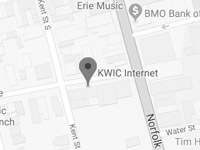Whether it’s a sudden increase in your prices, slow download speeds, or service outages, you’re likely here because you’re looking for an alternative to your current internet plan. Cable internet is a great solution to all these problems and more. It’s known to be “always on” and delivers beefier speeds than most of its competitors.
Interested? We don’t blame you! Here’s the lowdown on this can’t miss technology.
How Does a Cable Modem Connect to the Internet?
Your Internet Service Provider (ISP) uses fibre-optic cables to send a signal to the copper coaxial cable network that you use for your cable television. Once they arrive in your neighbourhood via connection junctions, these data signals travel the rest of the way to your modem in your home via the coaxial cabling.
From there, you have two options for how to distribute the internet in your home. With a separate wireless router connected via ethernet, you can set up Wi-Fi to enable access from anywhere in your home. This is a good option if there are many people online at once, or if you have a laptop that you tend to get up and move around with. Alternatively, you can use an ethernet cable and wire the connection directly to a PC, which will be even faster and more secure. Ethernet is great for desktops since you are already rooted to one spot due to the desktop form factor.
How Does Cable Internet Work with Cable TV?
Most neighborhoods already have coaxial cable infrastructures because of the high demand for cable TV over the past few decades. If you have cable television in your house, cable internet is automatically an option for you.
By connecting your TV and modem to the same coaxial cable, you can use the same network for both television and internet. Don’t worry, though: your internet won’t interfere with your TV signal. That means you can be on the internet while watching the news or your favourite channel.
What Can I Expect in Terms of Speed and Bandwidth?
ISPs now offer different cable packages based on the needs of the customer. The higher the speed, the more you’ll pay. Plans typically range from 30Mbps to a maximum of 1,000Mbps in download speeds, with most people choosing closer to 100Mbps. Some ISPs will only offer higher speeds in certain locations, where the coaxial cable infrastructure can guarantee the service. We recommend a minimum of 15 to 30Mbps in download speeds for a stable, reliable, and sufficiently zippy connection.
Speeds can be affected during peak times based on how many people in your neighborhood use the network since cable internet has limited bandwidth, but most neighbourhoods have capacity to spare for those really busy times. This is especially important if you have many internet users and devices in your home.
Why Should I Get Cable Internet?
If you’re one of the many people in Canada who has been affected by the recent CRTC decision, cable internet pricing is a hot topic. You want to make sure you have an ISP that prices plans fairly and works to get you the best value on cable internet. If you work from home or use the internet frequently, this is an ideal choice.
Coaxial cable infrastructures are very common as well, so it isn’t hard to get in your home, especially if you live in urban and suburban areas. If you stream television shows, livestream, play video games online, or download large amounts of content in other ways, cable internet caters to that lifestyle easily.
In addition, generally, cable internet is faster than other options, like DSL or wireless internet, which means faster downloads for data-heavy content. All of the devices and users in your house will have access to it at the same time, and it’s not as prone to dropouts or buffering as some of its competitors.
Are you looking for internet at affordable pricing, or a solution that lets you download content quickly and securely? Cable internet is likely the right choice for you, and KWIC Internet provides reliable, secure, and highly efficient options with incredible performance at competitive prices. Connect with us today for more information!
